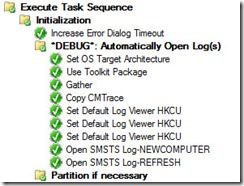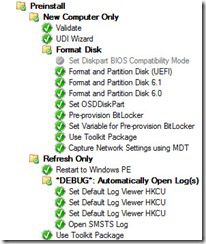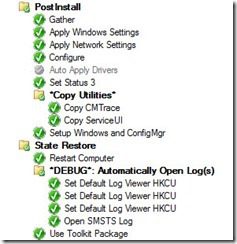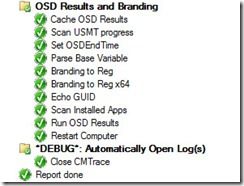I was doing an OSD project about 5 years ago when I came up with the idea of automatically opening the smsts.log file using Trace32 (now replaced by CMTrace). I am always up for a challenge to see if something can be done, so I set out to see if I could make it happen. By automatically opening the smsts.log, I could save a ton of time during the development and testing phase of engineering the task sequence.
Back in the ConfigMgr 2007 days, you would have to hit F8 in order to bring up the command prompt and then hopefully you remembered to put the Trace32 on the boot image for the WinPE phases. Now in CM12, CMTrace is included in the boot image, however, it is not in the path (see my other post called ConfigMgr 2012: Always including certain files in your Boot Images for a little trick to put CMTrace in the System32 directory so that it is in the path and can be launched from any directory). After you launch the log viewer for the first time, the first thing it does is ask you if you want to make it the default log viewer before it will continue. Setting a couple of registry keys ahead of time is all that it takes to prevent this from being displayed.
After that, it is a matter of launching the log viewer and calling smsts.log. There are two things to consider for this action: 1. Depending on the scenario (i.e. new computer or refresh), you need to know how to launch CMTrace and 2. Depending on the scenario and place in the task sequence, you need to know where the smsts.log is located. For #1, you can launch CMTrace directly if you are in WinPE or the newly installed OS during State Restore. If starting from a currently installed OS (i.e. refresh scenario), then you need to use a utility from the MDT Toolkit called ServiceUI.exe in order to make CMTrace visible. For #2, the smsts.log file starts in different locations based on the scenario and it also moves around during the task sequence.
With that said, let's take a look at the steps that need to get inserted into a ConfigMgr R2-MDT client task sequence:

Each *DEBUG* Group has a condition on the Task Sequence Variable DEBUG (DEBUG equals "TRUE"). This variable can be set on a Collection or System Resource.
Set OS Target Architecture: this step is used to set the architecture of the OS that is being applied. For an example, use the value x64 if the new OS being installed is Windows 8.1 Enterprise x64. This is used later in order to copy the correct architecture version of CMTrace and ServiceUI onto the target OS.
Use Toolkit Package and Gather: This step is used to obtain CMTrace (which needs to be copied into the MDT Toolkit Package) and ServiceUI utilities, and also determine the current architecture under the refresh scenario.
Copy CMTrace: This step is also used in the refresh scenario and is used to copy the correct architecture version of CMTrace into System32 (which minimizes the number of registry setting steps).
Set Default Log Viewer HKCU: These three steps set the necessary registry keys in order to prevent CMTrace from prompting to be the default log viewer. Yes, they could be done via a script with a package or a very long command line, but I kept them split out and in Run Command Line steps for simplicity.
Open SMSTS Log-NEWCOMPUTER: This step opens the smsts.log in a new computer scenario using the following command: cmd /c "start x:\Windows\System32\CMTrace.exe x:\Windows\Temp\SMSTSLog\smsts.log"
Open SMSTS Log-REFRESH: This step opens the smsts.log in a refresh scenario using the following command: "%deployroot%\tools\%architecture%\ServiceUI.exe" -process:tsprogressui.exe -nowait %WINDIR%\System32\CMTrace.exe %_SMSTSLogPath%\smsts.log
Each time the task sequence boots into a new OS, the above registry entries need to be set. The following screen shots show each of the phases below:
Refresh scenario booting into WinPE:

Copying CMTrace and ServiceUI into the new OS and then rebooting into the target OS:

Closing CMTrace at the end of the task sequence:

In summary, here are the steps for getting this up and running in your environment. This assumes that you already have MDT integrated with ConfigMgr 2012 R2:
1. Add both the x86 and x64 version of CMTrace.exe to your MDT Toolkit Package. They can be found in ConfigMgr install directory\OSD\bin\i386 and ConfigMgr install directory\OSD\bin\x64. In the MDT Toolkit Package place the x86 version in .\Tools\x86 and the x64 version in .\Tools\x64. Be sure to update your Distribution Points after adding the files.
2. Download the Client Task Sequence – DEBUG.xml and copy it into the SCCM directory where the Microsoft Deployment Toolkit is installed (i.e. C:\Program Files\Microsoft Deployment Toolkit\SCCM).
3. Use the Create MDT Task Sequence action and select Client Task Sequence – DEBUG in the Choose Template drop down. Complete the wizard and edit the newly created task sequence. Select the step Set OS Target Architecture and edit the value to reflect the architecture of the WIM that is being deployed.
4. Create a Deployment and target a Collection.
5. On the targeted Collection, create a variable called DEBUG and set the value to TRUE. Add some test machines, start a deployment and watch the smsts.log open automatically!
Originally posted on https://miketerrill.net/
TeamViewer DEX Helps with
Ensures a smooth and uninterrupted digital experience for employees, minimizing frustrations and unnecessary disruptions.
Optimize processes with enhanced visibility and automation, driving proactive remediations, exceptional service, and reduced costs.
Resolve IT issues proactively and in real-time to reduce service desk incidents, minimize downtime, and maintain smooth, efficient operations.
Identify, notify, and fix compliance drift, digital friction, and end-user frustration issues.
TeamViewer DEX for
Lightweight, always-on communication, real-time actions, and automated client health remediation,
Optimize hardware spend while facilitating proactive hardware asset management
Gain clear insights into software usage and reclaim underused, redundant, or vulnerable software.
Core Capabilities
TeamViewer DEX Platform
Helps IT teams improve end user experience, tighten security, reduce costs, and evolve IT Operations from cost center to strategic enabler.
Dig into original DEX analysis, case studies, on-demand webinars, and more.
Be a DEX leader with useful strategies, how-to guides, and fresh platform updates.
Select your specific use cases to see demo videos narrated by product experts.
Understanding key terms and concepts related to Digital Employee Experience.
What is Digital Employee Experience (DEX)?
From the software and hardware used each day to IT interactions, DEX is the total of all digital touchpoints an employee encounters at work.
Customer Success
How Britain’s Favorite Retailer has transformed endpoint management across more than 1,000 stores with 1E
About 1E
At 1E, we reimagine how technology serves people and create new ways for IT to shape the future of work.




